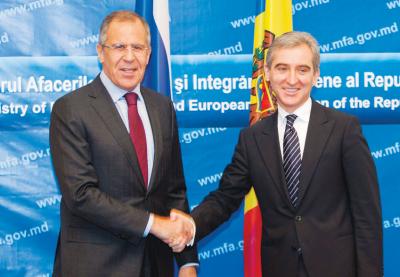
Lavrov Squashes Hope for Constructive Restart of Transnistria Negotiations
Publication: Eurasia Daily Monitor Volume: 8 Issue: 216
By:

International negotiations on the Transnistria conflict are scheduled to re-start on November 30-December 1, for the first time in almost six years. The OSCE’s Lithuanian chairmanship helped facilitate the re-start and will host the event in Vilnius in the 5+2 format (Russia, Ukraine, OSCE, United States, European Union, Chisinau, Tiraspol).
In a preparatory visit to Moldova on November 22, however, Russian Foreign Minister, Sergei Lavrov, presented unacceptable demands both old and new.
Russia seems prepared to undertake another attempt to “resolve” the Transnistria conflict by means of “reunifying” Moldova conditionally. This would involve a dysfunctional “federal” setup, open to Russian arbitration, and in the presence of Russian troops. This sort of reunification largely explains Lavrov’s November 22 professions of respect for Moldova’s territorial integrity, which Russian officials had mostly omitted even as lip service since 2008.
Moscow last undertook an attempt to “reunify” Moldova on Russia’s own terms and conditions through the 2003 Kozak Memorandum, which Moldova’s then-President, Vladimir Voronin, rejected at the last moment. On his November 22, 2011 visit to Chisinau, Lavrov publicly regretted the demise of the Kozak Memorandum as a missed opportunity for resolving the Transnistria conflict.
That document is not repeatable, but Moscow seems to aim for a Kozak-Lite version with the necessary updating. Not all of the updating is Lite, however. It now includes Russian attempts to broker an internal political settlement among Moldova’s squabbling politicians. This implies a more direct Russian intrusion into Chisinau’s internal politics, compared with Moscow’s earlier attempts to arbitrate between Tiraspol and Chisinau.
In two briefings and a speech to a university audience in Chisinau, Lavrov hinted at some of Moscow’s demands to be presented in the 5+2 negotiations (Interfax, RIA Novosti, Rosbalt, November 23; Russian Ministry of Foreign Affairs website. www.mid.ru, November 23, 24).
Russia seeks a political settlement “in the framework of Moldova’s sovereignty and territorial integrity, with a guaranteed special status for Transnistria,” and with “Russia as a mediator and guarantor of the settlement,” to be negotiated in the re-launched 5+2 format. According to Lavrov, the 2003 document on the principles of governance of a unified state [Kozak Memorandum] can serve for “reference and continuity” of the process. It aimed “to build a unified, independent, democratic, structured as a federation, with the participation of Transnistria and Gagauzia as federal units, and highest concern for human rights and freedoms.” By resurrecting this or a similar approach, however, Russia must again acknowledge Moldova’s territorial integrity, as it had done from 1992 to 2008, albeit on paper only.
Ironically, the United States, European Union, and OSCE (via its American-led Chisinau mission) dropped the principle of Moldova’s territorial integrity from the documents they submitted in June and September 2011 as the basis for re-launching the 5+2 negotiations. Eager for the process to restart, Western negotiators gave in to Moscow and Tiraspol on that issue. Only the Ukrainian document supported Moldova’s territorial integrity (see EDM, June 6, 8, 21, 22, September 26). Now that Russia itself has (for its own tactical considerations) reverted to recognizing Moldova’s territorial integrity, the least that the US, EU, and OSCE (under a newly appointed American mission chief in Chisinau) can do is to amend their documents accordingly.
Reaffirming what has been Russia’s position since 2001, Lavrov stated that Russian troops will not withdraw from Transnistria before the conflict has found a political resolution (Moscow deems it a conflict between Chisinau and Tiraspol, not between Moscow and Chisinau). Given the demise of the Treaty on Conventional Forces in Europe, Lavrov easily waved off Russia’s 1999 Istanbul Commitments to withdraw its troops as part of that treaty.
Lavrov drew the usual, artificial distinction between Russian troops guarding the ammunition stockpiles and Russian “peacekeepers.” He stated that the ammunition-guarding troops would withdraw if progress is made toward resolving the conflict, and if “Transnistria’s leadership” therefore allows those stockpiles to be evacuated or recycled. The Russian “peacekeepers,” however, would be included in a “multilateral peacekeeping mission,” again conditional on progress toward a political settlement, and subject to further agreement among “the parties.” “Our proposals of eight years ago [2003] provide for this,” Lavrov said, alluding to the Kozak Memorandum’s supplement that envisaged a 20-year post-conflict stationing of Russian troops. As has been the case throughout the history of these negotiations, Moscow reserves for itself and for Tiraspol a double veto power, on both the political and the military tracks of the negotiating process.
Russia accepts Moldova’s pro-European course, but “does not want this to be pursued at the expense of other relationships,” according to Lavrov. Moreover, “It is important that all of the state’s decisions on the foreign policy vector [should] reflect Moldova’s permanent neutrality as inscribed in its constitution. Moldova must not ignore the opportunities open to it in both geographic directions,” he stated (Rosbalt, November 23).
With this, Moscow is hinting again that it deems Moldova’s European integration course to be ultimately incompatible the country’s permanent neutrality. This consideration bears directly on the Transnistria conflict-resolution process. Russia demands strict observance of Moldova’s neutrality as one of the preconditions to conflict-resolution. Russia apparently construes Moldova’s neutrality not only as staying out of NATO, but also as equidistance between the European Union and Russia. Moscow will therefore continue freezing the Transnistria conflict, hoping ultimately to shift Moldova’s European course toward a double-vector course. At the same time, Russia deems the presence of its own troops in Moldova to be compatible with the country’s neutrality.
Overall, Russia seeks to maintain the conflict in its frozen situation as a minimal objective. The maximal objective is to start a process of “reunifying” Moldova on Russian terms, in a dysfunctional “federation,” with a Russian droit de regard on a would-be “federation’s” foreign policy. Lavrov’s mention of Gagauzia as a further “federal” entity can be seen as a calculated attempt to fan tension in Moldova’s south.
Russia’s goals are almost certainly unattainable if Moldova’s present government under Vlad Filat continues in power in Chisinau. European integration is this government’s overriding priority and it will not be compromised. However, political infighting in Chisinau seems about to result in new elections, with wider opportunities for Russia to intrude into Moldovan politics. Moscow’s positions, as articulated by Lavrov in Chisinau, are designed to block any progress in the 5+2 format, so as to render its re-start meaningless.




